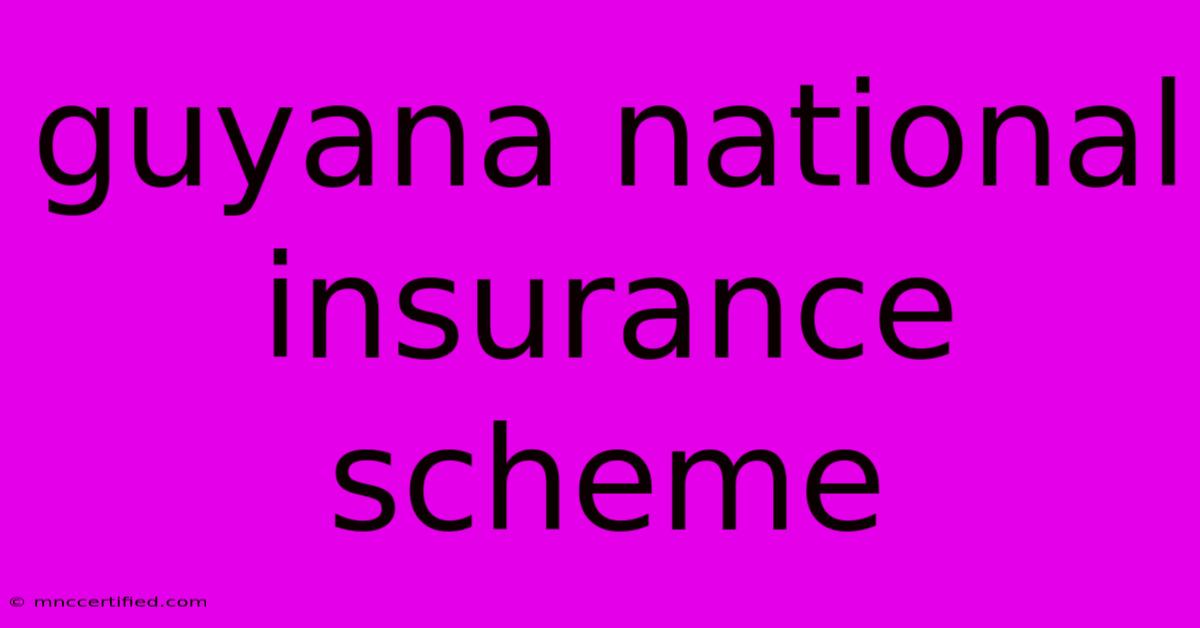Guyana National Insurance Scheme

Table of Contents
Understanding the Guyana National Insurance Scheme (GNIS)
The Guyana National Insurance Scheme (GNIS) is a vital social security program in Guyana, providing crucial financial support to its citizens during times of need. Understanding its intricacies is key for every Guyanese worker and resident. This comprehensive guide will cover key aspects of the GNIS, from eligibility and contributions to benefits and claims processes.
Eligibility for GNIS Benefits
To be eligible for GNIS benefits, you generally need to be a contributory member. This means you've made regular contributions to the scheme. Contribution periods vary depending on the specific benefit you're claiming. There are specific rules regarding:
- Employed persons: Employers are legally obligated to deduct contributions from your salary and remit them to GNIS.
- Self-employed persons: You must register with GNIS and make voluntary contributions.
- Voluntary contributors: Individuals not employed but wishing to receive benefits can contribute voluntarily. Note that there are specific requirements and limitations for voluntary contributions.
It's crucial to verify your eligibility status with the GNIS directly to ensure you meet all requirements for the benefits you intend to claim. This often involves checking your contribution records.
Specific GNIS Benefit Eligibility Requirements
Each GNIS benefit has its own eligibility criteria. These often involve minimum contribution periods, age requirements, and specific circumstances such as illness or injury. Some key benefits include:
- Old-age pension: Requires a specific number of contributions over a certain period.
- Invalidity pension: Requires proof of permanent disability.
- Survivor's pension: Paid to the surviving spouse or dependent children.
- Maternity benefit: Paid to employed female contributors.
- Sickness benefit: Paid for temporary illness preventing work.
Contributing to the GNIS
Understanding how contributions work is paramount. Contributions are typically a percentage of your insurable earnings, deducted at source if employed. For self-employed individuals, contributions are made directly to GNIS.
Key aspects of GNIS contributions:
- Contribution rates: These are set by the government and periodically reviewed. Ensure you're aware of the current rates.
- Contribution ceiling: There's usually a maximum insurable earnings limit. Contributions are only calculated on earnings up to this limit.
- Contribution records: Regularly check your contribution records with GNIS to confirm accurate deductions and contributions. Any discrepancies should be reported immediately.
GNIS Benefits Explained
The GNIS offers a range of benefits designed to support individuals and their families during various life stages and circumstances. These include:
- Old-age pension: A monthly payment upon retirement, providing financial security in old age.
- Invalidity pension: A monthly payment for individuals permanently disabled and unable to work.
- Survivor's pension: A monthly payment to the surviving spouse and dependent children of a deceased contributor.
- Maternity benefit: A cash payment to assist with maternity costs.
- Funeral grant: A lump-sum payment to assist with funeral expenses.
- Sickness benefit: A payment for temporary incapacity to work due to illness.
The amount of each benefit is calculated based on the individual's contribution history.
Claiming GNIS Benefits
The process of claiming GNIS benefits typically involves completing a claim form and providing necessary documentation. This often includes proof of identity, medical certificates, and contribution records.
Key steps in filing a GNIS claim:
- Obtain the correct claim form: Download the appropriate form from the official GNIS website or obtain it in person at a GNIS office.
- Complete the form accurately: Ensure all information is correct and up-to-date.
- Gather supporting documentation: Collect all necessary documentation to support your claim.
- Submit your claim: Submit your completed form and supporting documents to the relevant GNIS office.
- Follow up: After submitting your claim, follow up with GNIS to inquire about the status of your application.
Be prepared for potential processing times. It is advisable to submit your claim well in advance of needing the benefit.
Contacting the Guyana National Insurance Scheme
For further information, clarification on eligibility, or to address any queries about your contributions or benefits, it's recommended to visit the official GNIS website or contact them directly through their designated contact channels. This might include phone numbers, email addresses, or physical office locations. Always refer to official GNIS sources for the most accurate and up-to-date information.
Keywords: Guyana National Insurance Scheme, GNIS, Guyana social security, old-age pension, invalidity pension, survivor's pension, maternity benefit, sickness benefit, funeral grant, contribution rates, eligibility, claim process, benefits, Guyana, social security benefits
This article provides a comprehensive overview of the Guyana National Insurance Scheme. Remember to always consult the official GNIS website or contact them directly for the most accurate and up-to-date information. This information is for general guidance only and does not constitute financial or legal advice.

Thank you for visiting our website wich cover about Guyana National Insurance Scheme. We hope the information provided has been useful to you. Feel free to contact us if you have any questions or need further assistance. See you next time and dont miss to bookmark.
Featured Posts
-
Puerto Rico State Insurance Fund
Nov 21, 2024
-
My Friends Boba Addiction
Nov 21, 2024
-
21 15 An Hour Is How Much A Year
Nov 21, 2024
-
Powerful Bomb Cyclone Hits Wa
Nov 21, 2024
-
Independent Insurance Agent Logo
Nov 21, 2024